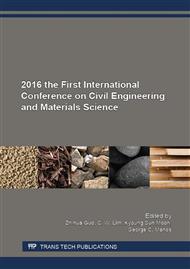p.53
p.58
p.63
p.68
p.73
p.78
p.83
p.88
p.94
Economic Exploitation of Gravel in Place of Granite in Concrete Production
Abstract:
The paper investigated the application of gravel as partial economic replacement of granite in concrete production. Concrete was produced using granite/gravel combination in varying percentages of 90/10, 80/20, 70/30, 60/40, 50/50, 40/60, 30/70, 20/80 and 10/90. Concrete made from 100 % granite and 100 % gravel served controls while other constituents of concrete were kept constant. Two different mix ratios of 1:2:4 and 1:3:6 were employed. Sieve analysis was carried out on the aggregates, while slump and compaction factor tests were carried out on fresh concrete. Compressive strength tests were performed on hardened concrete. Specimens were produced using 150 mm cubes for compressive tests. The reliable percentage of granite/gravel combination from compressive strength view point 60/40 with a value of 21.15 N/mm2 for mix ratios 1:2:4 and 70/30 with 15.17 N/mm2 for 1:3:6 mix ratio at 28 days. Satisfying respectively the 20 N/mm2 and 15.17 N/mm2 minimum requirement of BS 8110: 1997.There were costs saving of 4 % per unit volume of concrete production for both 1:2:4 and 1:3:6 respectively. Empirical evidence from the regression analysis revealed that higher composition of gravel significantly improves the concrete consistency properties while greater proportions of granite do significantly enhance comprehensive strength.
Info:
Periodical:
Pages:
73-77
Citation:
Online since:
August 2016
Keywords:
Price:
Сopyright:
© 2016 Trans Tech Publications Ltd. All Rights Reserved
Share:
Citation:


